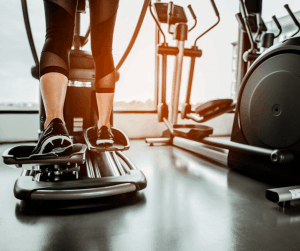So you can’t run, now what do I do?
So you have been training for months for a race and running the best you have in years only to be stopped short by an injury. This is not an uncommon story unfortunately but don’t throw in the towel just yet. You need to switch gears and start to cross-train or switch to an exercise that does not cause your pain and is easier on your body. Cross-training can be very beneficial to runners. ( Etxebarria N, Mujika I, Pyne DB. Training and Competition Readiness in Triathlon. Sports (Basel). 2019;7(5).) While running may be one of the best workouts, sometimes pushing yourself too hard can lead to aches and pains especially as we get older. Getting injured is no fun but it doesn’t mean you can’t workout at all. I have been running for almost forty years now and have had to modify my running periodically due to pain or injuries and I think that has allowed me to run for so many years.
There are several things to consider when you are injured, but the first thing is to find out what your injury is and what activities you can do without triggering pain. If your podiatrist diagnoses you with heel pain/plantar fasciitis, you can try to continue your exercise program with something that is lower impact and limits the pressure on your heel. There are several options for cross-training and hopefully you can find one that you enjoy as much as running.
Options for Cross-training:

Cycling or Spinning: Cycling and spin classes are also low-impact ways to boost your cardiovascular fitness and strength. Cycling exercises use different muscle groups than running does so it helps balance your muscles.
Elliptical: The elliptical machine has an oval-like (ellipse) motion, which provides the user with the feel of classic cross-country skiing, stair climbing, and walking all in combination. Because the muscles used on the elliptical are similar to those you use when running, the machine is a good low-impact alternative when an injury prevents you from running.
Weight training and core work: Weight training and core work should always be part of your training plan and if you are injured you should have extra time to improve your core strength and flexibility which are all important elements for running that are often ignored.
You may be more partial to one of these activities more than others, but all are great exercises that can be advantageous. I used to strictly run, but once I started cross training by adding spin classes and outdoor cycling to my routine, my running improved. It’s always a great idea to vary your exercises daily to prevent injury, but when you are injured just find the one that you can do without pain.
If you are training for a half-marathon or some other distance, cross-training doesn’t mean you will lose your fitness. You may have to push yourself a little harder on the elliptical machine or while you are in spin class to get the same workout as you do on the track, but it is possible. Weight training and core exercises are always a good idea, but if you are injured this is an excellent time to step up your game. If you’ve pulled your hamstring or injured your knee, strengthening your hamstrings and quadriceps can be a great way to come back from injury and prevent this from happening again. With the Corona Virus still out there, going to the gym can be a problem. Don’t forget to maintain your distance while in the gym, clean the equipment before and after use, bring your own water and wash your hands on a regular basis.
Once you are ready to return to running, be smart and start slow. You definitely don’t want to set yourself up for reinjury. Continue to cross-train as you slowly return to running. If you are patient, your chances of a smoother transition back to running are much better. You may be surprised how little fitness you have lost. Alternating your exercises or cross-training is always a good idea in preventing injury and is definitely a great idea to maintain your fitness and sanity when you get injured.

[text-blocks id=”4288″ slug=”disclaimer”]
[mashshare]
